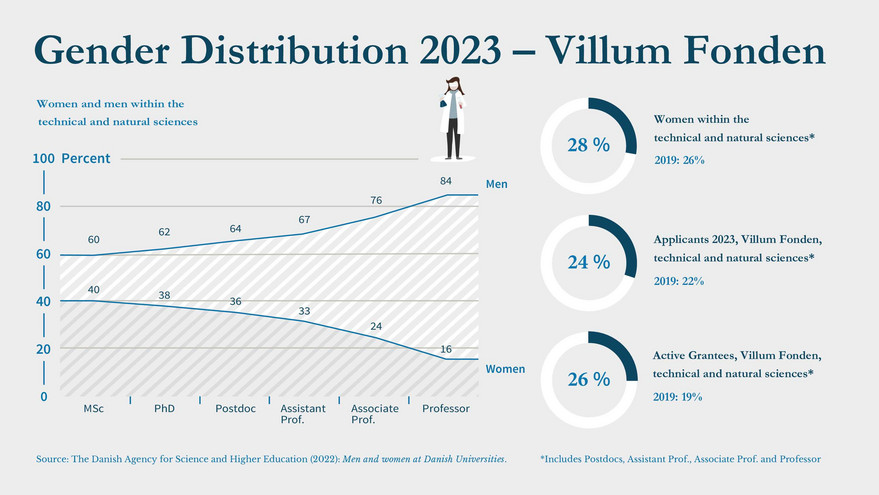
Gender policy
There is ample scientific evidence to suggest that diversity within research leads to more creativity and innovation. At VILLUM FONDEN, we seek to support an increasingly diverse and inclusive scientific community within the technical and natural sciences at Danish universities, and we have chosen to focus mainly on addressing female representation.
Hence, we are committed to:
- Promote gender balance within Danish Science
- Support the advancement of talented women in university research careers
- Motivate female researchers to apply for funding
- Act on reducing career barriers for female researchers
- Support initiatives that promote a more inclusive research environment.
VILLUM FONDEN recognises persons with all gender perceptions and gender identities. When administering grants, the foundation relies on the legal gender at the date of application.

The nationwide gender distribution from PhD to full professor follows the scissor shape depicted in the figure above. The current gender distribution within Villum Fonden is included in the figure.
Our targets
- The gender distribution among applicants and grantees within our programmes should match the gender distribution in the pool of overall potential applicants
- Our committees should include at least 30-40% women.
Our initiatives
Below you find examples of how we actively address our support to a more gender balanced scientific community.
Funding instruments
- Villum International Postdoc Programme is earmarked for women (5 years): we give women with academic career ambitions an international experience.
- Family packages support family related needs of researchers.
Calls
- Adjust calls for all programmes, encouraging women to apply, and ensure that the wording of all calls is gender neutral
- All family related leaves of absence are considered, and the eligibility window is expanded accordingly.
Application and evaluation
- Monitor the gender distribution at interviews with applicants
- Introduce targets for female representation among applicants and female share of grantees
- Introduce targets for female representation in committees, panels and external reviewers
- Present gender data for selection committees when evaluating proposals
- Regularly review evaluation procedures to detect gender bias: e.g. by inviting an external observer to participate in committee meetings and by setting up specific gender balance guidelines.
Follow up/Monitoring
- Monitor gender data and targets
- Introduce gender data on foundation website
- Discuss gender distribution at follow-up meetings with grantees.